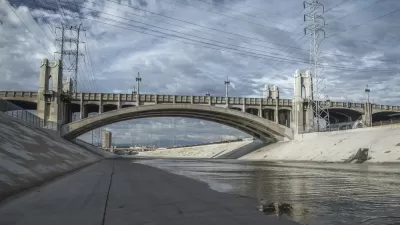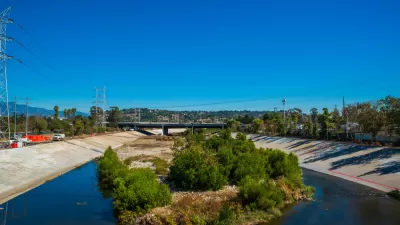A new draft Los Angeles Master Plan, created by Frank Gehry's firm, lays out a more active, natural vision for the river, in addition to addressing concerns about displacement in communities along the river corridor.

Los Angeles County this week released a draft update to the Los Angeles River Master Plan.
Steven Sharp reports on the document, which is "intended to guide the development of new parks and water quality projects along the 51-mile corridor, while also accounting for potential displacement and equity issues in neighboring communities."
The Los Angeles River was infamously encased in concrete after a series of destructive storms in the early 20th century, but, as Sharp notes, "sparse rainfall in Southern California mean's that the river is only needed for its flood control functions roughly 2 percent of the time [.....] That creates an opportunity for recreational activities and public open space on much of the corridor."
Sharp summarizes some of the plan's approach to development potential along the river thusly:
Although the master plan does not effectuate any specific investments along the river, the document identifies 56 potential projects between the San Fernando Valley and the South Bay. In addition to building off of existing proposals - such as a 42-acre park at the Taylor Yard or the Downtown leg of the L.A. River bike path - the plan includes a "kit of parts" outlining an array of improvements to the channel, ranging from more modest river trails to channel modifications and even flood plain reclamation.
The county hired architect Frank Gehry's firm, working with landscape architect Laurie Olin, to complete the master plan. An article by Louis Sahagún for the Los Angeles Times devotes more ink to the starchitect angle inherent to the release of the draft master plan. Olin's contribution to the plan, according to Sharp, is a vision for "100 miles of public trails along the river, as well as park projects that restore habitats and improve water quality."
Gehry's role on the Los Angeles River has been controversial in the past. Gehry's firm was working in the background without public attention early in the process, but Gehry's initial work focused on hydrology, so the scope of the planning work has clearly expanded since then. At the time, concerns included a lack of understanding about how Gehry's work fit in with the Los Angeles River Revitalization Mater Plan, approved in 2007, and a plan released in 2013 by the U.S. Army Corps of Engineers that shifted the focus of planning and engineering along the river to include habitat restoration in addition to stormwater protection.
FULL STORY: Here's a Look at the Updated L.A. River Master Plan

Planetizen Federal Action Tracker
A weekly monitor of how Trump’s orders and actions are impacting planners and planning in America.

Map: Where Senate Republicans Want to Sell Your Public Lands
For public land advocates, the Senate Republicans’ proposal to sell millions of acres of public land in the West is “the biggest fight of their careers.”

Restaurant Patios Were a Pandemic Win — Why Were They so Hard to Keep?
Social distancing requirements and changes in travel patterns prompted cities to pilot new uses for street and sidewalk space. Then it got complicated.

Platform Pilsner: Vancouver Transit Agency Releases... a Beer?
TransLink will receive a portion of every sale of the four-pack.

Toronto Weighs Cheaper Transit, Parking Hikes for Major Events
Special event rates would take effect during large festivals, sports games and concerts to ‘discourage driving, manage congestion and free up space for transit.”

Berlin to Consider Car-Free Zone Larger Than Manhattan
The area bound by the 22-mile Ringbahn would still allow 12 uses of a private automobile per year per person, and several other exemptions.
Urban Design for Planners 1: Software Tools
This six-course series explores essential urban design concepts using open source software and equips planners with the tools they need to participate fully in the urban design process.
Planning for Universal Design
Learn the tools for implementing Universal Design in planning regulations.
Heyer Gruel & Associates PA
JM Goldson LLC
Custer County Colorado
City of Camden Redevelopment Agency
City of Astoria
Transportation Research & Education Center (TREC) at Portland State University
Camden Redevelopment Agency
City of Claremont
Municipality of Princeton (NJ)





























